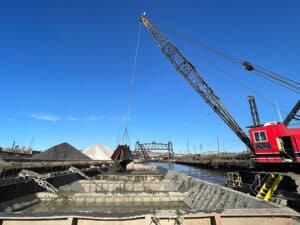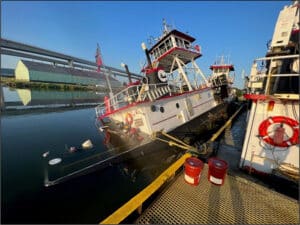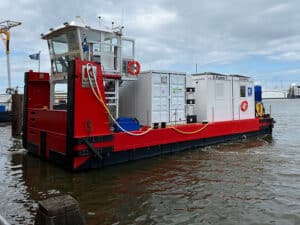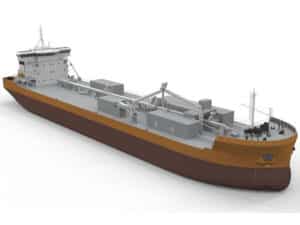
NTSB reports on $1.8 million towboat engineroom fire
Written by Marine Log Staff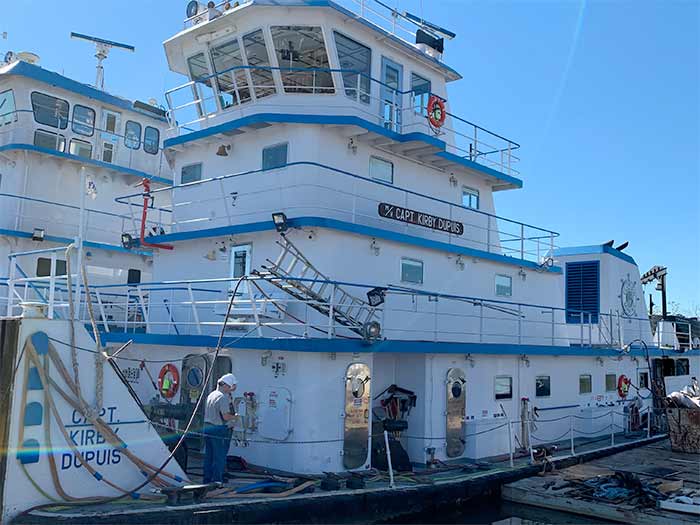
Capt. Kirby Dupuis docked after the engine room fire fire. (Source: NTSB)
A missing retaining ring and mounting bracket on the port main diesel engine led to an engineroom fire on a towboat near Belleview, Ky., the National Transportation Safety Board (NTSB) says.
The towing vessel Capt. Kirby Dupuis was pushing loaded dry cargo barges on the Ohio River when a fire broke out on its portside engine on November 9, 2021. The crewmembers fought the fire using portable extinguishers and attempted to activate the vessel’s fixed fire-extinguishing system. The fire was eventually extinguished by local firefighters. No pollution or injuries to the six-person crew were reported.
The vessel sustained an estimated $1.8 million in damages. Contributing to the severity of the damage, says the NTSB, was the crew’s unfamiliarity with activation procedures for the fixed fire-extinguishing system, which resulted in an unsuccessful attempt to release the fire suppression fluid and extinguish the fire.
MISSING PARTS
Following the fire, NTSB investigators reviewed the vessel’s video system which showed lube oil spraying inboard from the port main engine. About 10 seconds later, a flame was seen at the top of the forward part of the engine. An inspection of the engine found a broken O-ring and the retaining ring missing from where the tube connected to the lube oil filter housing. Additionally, supporting clips and mounting hardware for the lube oil tube were missing on the port main engine in the mid-section area, and the bolt that had held the supporting clips appeared to be sheared. It is not known how long the supporting clips and hardware had been missing from the engine. The last major work on the engine, a top end overhaul, was in May 2018.
The crew attempted to use the fixed fire-extinguishing system for the engineroom, however investigators determined the system was not activated during the fire. One of the two levers required to activate the system was not fully extended. As a result, the nitrogen gas from the pilot cylinder did not discharge. Although the crew drilled regularly, none of the drills included training on the fixed fire-extinguishing system. The owner of the vessel is currently developing a training video on the fixed fire-extinguishing system, which will become required training for their crews.
The NTSB determined the probable cause of the engineroom fire was a lube oil tube on the port main engine that vibrated out of a joint due to a missing retaining ring and mounting bracket. It sprayed pressurized oil that made contact with a hot exhaust surface and ignited.
Contributing to the severity of the fire damage was the crew’s unfamiliarity with activation procedures for the fixed fire-extinguishing system, which resulted in an unsuccessful attempt to release the fire suppression fluid and extinguish the fire.
“The small confines of the engineroom space and the location of fire equipment within that same space demonstrate a risk to crews fighting engine room fires,” the report said. “On towing vessels, the risk to crews fighting engine room fires has led to the development of designs that incorporate both a means for securing ventilation to the engine room and a fire-extinguishing system to extinguish the fire without requiring crews to enter the space. Crewmembers should train for engineroom fires and review extinguishing system instructions. Training drills should ensure that crewmembers are familiar with fixed fire-extinguishing systems and procedures, including confirming crew evacuation, isolating the protected space, and activating the system.”

